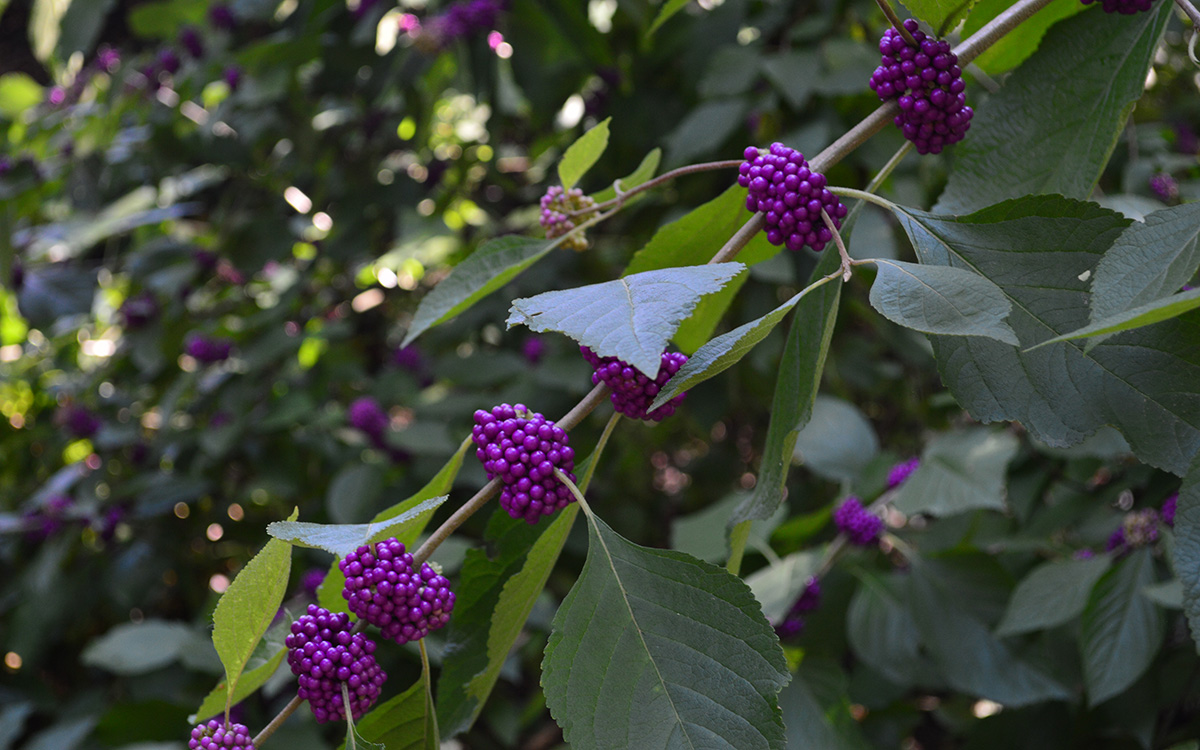Late summer through autumn, millions of birds pass through the Southern Plains on their migration to southern wintering grounds. Birds follow four main paths as they migrate. The Southern Plains Region lies at the heart of the largest of these, the Central Flyway. Roughly half of North America’s migratory waterfowl use the Central Flyway, as well as many shorebirds, including sandhill cranes.
Of particular interest to gardeners are the hundreds of songbird species that also migrate through the Southern Plains on their way to warmer climes. To fuel the flight, many birds that fed on insects throughout the summer switch to high-energy foods in fall, particularly fruits of native shrubs and trees. Gardeners can give birds a boost by planting a diversity of native fruit-bearing plants in the landscape to help fuel migrations.
Fruiting trees to feed migrating songbirds
Fruiting trees like Carolina buckthorn (Frangula caroliniana, syn. Rhamnus caroliniana, Zones 5–9) and rusty blackhaw (Viburnum rufidulum and cvs., Zones 5–9) not only provide fruits to birds, but also give them a place to rest. The dense branches provide protection for the birds during the day between their nighttime migration flights. Both plants grow as small trees or large shrubs reaching 10 to 20 feet tall and wide. These adaptable species tolerate heat and drought, as well as the alkaline soils common to many areas of the Southern Plains. Plant them in partial shade to full sun. Carolina buckthorn, notable for its golden fall foliage and burgundy-black berries, is perhaps the better landscape specimen. Rusty blackhaw puts on a better spring floral display, with clusters of white flowers in April and May that attract butterflies and other pollinators.
Shrubs with berries for migrating birds
There are a number of landscape shrubs that not only offer beautiful ornamental displays but also are favorites of birds. Perhaps the most beloved of these is American beautyberry (Callicarpa americana and cvs., Zones 6–10), adored by gardeners and birds alike for its vibrant purple autumn berries. The fruits seldom last to winter, as they are devoured by catbirds, wood thrushes, northern mockingbirds, and American robins, but they put on a gorgeous display until then. Plant in full to partial sun for optimal fruiting. Beautyberry tolerates clay soil and dry conditions once established. It can reach up to 8 feet tall and 6 feet wide.
Other shrubs to consider for fueling bird migrations include strawberry euonymus (Euonymus americanus, Zones 6–9) and Southern wax myrtle (Morella cerifera, syn. Myrica cerifera, Zones 7–9). The red strawberry euonymus fruits dangle from the branches of the 4- to 6-feet-wide-and-tall shrub and are enjoyed by a variety of songbirds. Wax myrtle can get considerably taller in the wild, growing into a small tree 20 feet tall and 10 feet wide. But in cultivation it typically only reaches around 10 feet tall and 8 feet wide. Its berries are gobbled up by tree swallows, yellow-rumped warblers, and scarlet tanagers, among others.
Fruiting vines that provide food for migrating birds
When selecting plants for birds, it is important to consider vines. Not only do vines offer fruits and flowers, but they can provide excellent shelter and summer nesting sites as well. A seldom-used native certainly worth its space in the landscape is American bittersweet (Celastrus scandens and cvs., Zones 3–8). This native is not to be confused with its invasive Asian relative, Oriental bittersweet (Celastrus orbiculatus and cvs., Zones 4–8). American bittersweet produces an abundance of showy, bright orange berries in late summer and early autumn. Plant in full sun to partial shade. This twining vine reaches lengths of 20 feet, spreading 2 to 8 feet wide. Plants tolerate salt, clay, and alkaline soils.
Coral honeysuckle (Lonicera sempervirens and cvs., Zones 4-9) is excellent for fueling migrations of hummingbirds, which also need energy for their long-distance migration. Hummingbirds migrate throughout September and October, so keep those feeders filled, and provide lots of flowering plant material. Coral honeysuckle also produces small red berries that attract and feed migrating songbirds. A quick grower to 10 to 20 feet tall and 3 to 6 feet wide, coral honeysuckle has lovely blue-green evergreen foliage and periodic flowers throughout the season. Plant in full sun, and provide plenty of moisture to establish.
Leave some “weeds” for the birds too
Many of the plants that volunteer themselves in our landscapes are excellent for wildlife. When it comes to fruit, pokeweed (Phytolacca americana, Zone 4–8) is tops. The dark purple berries are eaten by eastern kingbirds, summer tanagers, thrushes, and great-crested flycatchers. Rough-leaf dogwood (Cornus sperifolia var. drummondii, syn. Cornus drummondii, Zones 5–8) provides shelter and berries for migrating songbirds. Also consider allowing Virginia creeper (Parthenocissus quinquefolia and cvs., syn. Vitis quinquefolia, syn. Ampelopsis quinquefolia, Zones 3–9) to ramble along the wood’s edge. This vine produces gorgeous red fall foliage and berries that attract great-crested flycatchers, red-eyed vireos, eastern kingbirds, hermit thrushes, and others.
Maintaining an abundance and diversity of fruiting plants is a great way not only to attract songbirds to your landscape, but also to assist them on their long southward journey in the fall.
—Kim Toscano is a horticulturalist based in Stillwater, Oklahoma. She previously hosted Oklahoma Gardening, a weekly PBS television program produced by the Oklahoma Cooperative Extension Service.
Photos: Kim Toscano





